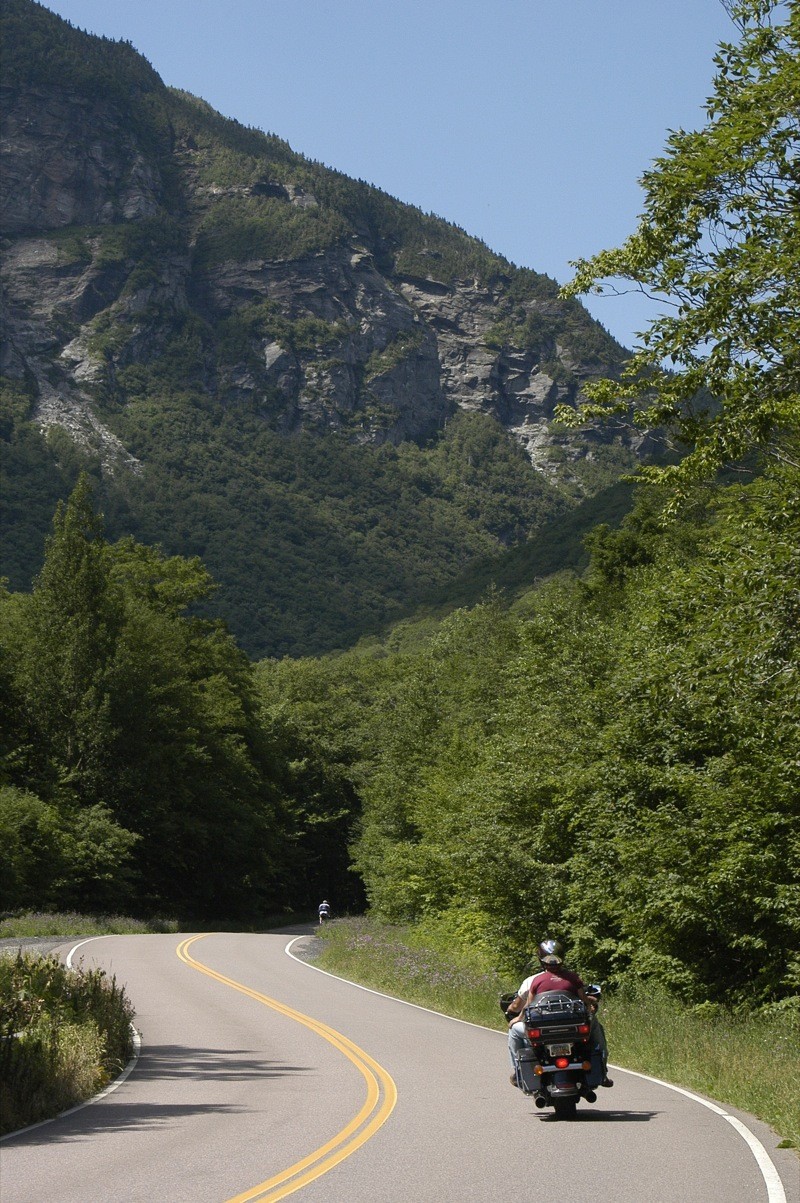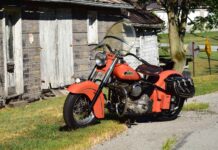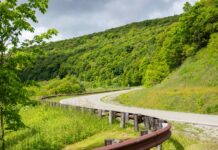Green Mountains, Vt. — We crossed south of the border and rode into the islands—the Champlain Islands, that is. For the past week Shadow and I had been restaurant hopping across the Outaouais region of Quebec and decided to extend our moto-foodie tour into the Green Mountains.

Native Americans had been living on the shores of this lake for 8,000 years before the first European arrived. For the next two centuries France, England and eventually the United States would fight to control this strategic waterway. Our first stop is on Isle LaMotte at Saint Anne’s Shrine, a Jesuit open-air chapel at the place where Samuel de Champlain camped in 1609 and, in 1666, Captain LaMotte established the first European settlement in Verd Mont. The oldest coral reefs in the world are found here, and this fossilized gray limestone was used to construct the Brooklyn Bridge, the facade of Radio City Music Hall in New York City and that of the U.S. Capitol in Washington D.C.
Bucolic is the best word to use when describing the Champlain Islands. Expansive views of blue water blending into the Adirondack horizon unfold to the west, the Green Mountains forming the skyline to the east as we roll across the island of North Hero and onto Grand Isle. The summer population is as much French Canadian as it is American, and this island paradise doesn’t fit the popular conception of Vermont scenery.

We tend to think of log cabins as part of the western frontier, yet the oldest surviving log cabin in the nation is in Vermont. Built in 1783 by Jeddiah Hyde, it was occupied by his descendants for 150 years. It’s now situated between the Block schoolhouse, circa 1814, and the current high school on Grand Isle.
After crossing the Sandbar Causeway and passing through the wetlands of the Lamoille River delta, we head south to the state’s primary city, Burlington. The city’s metropolitan area has a population of close to 215,000—small for a U.S. city, but it roughly holds a third of the population for the entire state. Our digs for the night are the upscale Vermont Hotel located downtown near the waterfront. Japanese-inspired shoji walls and Danish/Vermont minimalism décor make this boutique hotel unique in the region. A big plus is the coffee centers located by the elevators on each floor—hello, cappuccino!
Champlain College and the University of Vermont sprawl along the ridge while the vibrant downtown area lies on the steep slope that melds into the enticing public waterfront. Unique locally owned restaurants, college bars and upscale boutiques are a signature of this city’s pedestrian-only Church Street. Some are new, while others are favorites I frequented during decades past.
We scouted the area. I savored a beer at the Boathouse on Lake Champlain while Shadow just took in the view with a huge grin on her face. A free concert was taking place in Battery Park and the ubiquitous Ben & Jerry’s Ice Cream truck—B&J started as a scoop shop in downtown Burlington using a five-gallon homemade ice cream maker—was handing out free ice cream. Sweetwaters, an old favorite of mine, was chosen from among the numerous Church Street restaurants that featured outside patios. The atmosphere was a blend of Montreal and Boston with a Vermont twist and, after the heat of the day, the evening seemed idyllic.
The next day we had different itineraries. I went a few miles south to the town of Shelburne and the former country estate of Lila Vanderbilt Webb. Dating back to 1886, this property was originally 3,800 acres in extent —plus another 200,000 acres across the lake—and now forms the core of the Adirondack Park, which exemplifies the modern agricultural movement of the late 19th century. In 1972 much of the farm became a nonprofit organization dedicated to conservation education. With the backdrop of Lake Champlain and New York’s Adirondack Mountains, a landscape by Frederick Law Olmsted, and major buildings designed by Robert H. Robertson, the property is absolutely stunning. This time I only went to the Farm Barn, a Bavarian castle-inspired barn with an enclosed yard that’s two acres in extent. No, it’s not a typical cow barn for Vermont, or anywhere else. Shelburne Farm’s herd of Brown Swiss cows now reside at the dairy barn and only the milk is brought to the cheese-making operation in the Farm Barn. My goal was to learn a bit about farmstead cheddar from cheese maker Nat Bacon.

Naturally I favored the scenic local roads while riding from Shelburne to Richmond and ran through the Winooski Gap to reach Waterbury. Located at the intersection of Routes 2 and 100, this crossroads is home to the headquarters of Keurig Green Mountain—the largest free-trade coffee company in the world—and Ben & Jerry’s Ice Cream. Heading north on Route 100 I passed by the Alchemist, which produces Heady Topper, one of the world’s highest-ranking craft brews, B&J’s main factory, the Cold Hollow Cider Press, and one of Cabot Cooperative Creamery’s four international retail outlets. The DOT should change the Vermont registration plate logo from “SEE VERMONT” to “COME EAT.”
Stowe, Vermont, is the self-proclaimed “ski capital of the East,” but this little village is also a busy place during the summer season. It’s also internationally renowned for the number of award-winning restaurants operating here. To avoid the village center I turned onto Moscow Road and rode past the turn to the Trapp Family Lodge (Sound of Music fame) to reach Route 108 near CROP Bistro & Brewery. I continued to our rendezvous at the luxurious Stowe Mountain Lodge at the base of the famous ski slopes. This is the last of a plethora of hotels and resorts strung along Route 108, a.k.a. The Mountain Road. Beyond the lodge one begins to climb into Smugglers Notch, a glacially carved pass between the two highest peaks in the state. Here riders have to negotiate radically banked curves where the narrow band of asphalt literally hugs the sides of boulders weighing hundreds of tons while climbing the steep grade between towering cliffs. Needless to say, there’s plenty of motorcycle traffic on this road.

The Stowe Mountain Lodge is five-star accommodations, plus they were one of the original promoters of the farm-to-table food movement in Vermont. I barely had time to check in before Shadow arrived, fresh from her extensive Ben & Jerry’s exploration, and we were given a VIP tour of the place. However, hunger struck and soon we were sitting in the lounge area eating flatbread pizza from their wood-fired brick oven.
The next morning began with a sumptuous breakfast before packing up and heading to CROP (Customized Restaurant Operations Platform) Bistro & Brewery for lunch. I taste-tested their current brews and rated them while waiting for lunch to arrive. There are no fancy white linens or menu items most of us can’t pronounce at CROP, just excellent food that keeps regular customers coming back for more. I sampled the Cheddar Lager Soup and beer-battered fried pickles. Then a hand-rolled, German-style pretzel with brown ale mustard for dipping arrived, followed by a trio of handmade tacos with duck confit, pulled pork and grilled chicken. Oh, there was more, but, as with all menus based on locally sourced foods, it changes with the season and even by the week.
My motto is “ride to eat; eat to ride,” so we hit the road. Back in Waterbury a craft show had taken over the main streets in the village. We stopped to browse the offerings. Such spontaneously discovered happenings are part of touring adventures.
We meandered through the mountains on Route 100, the popular motorcycle-touring byway that connects with the “gap roads” that twist over the passes and down to the broad Champlain Valley of western Vermont. There are not that many miles between Stowe and Killington, but little stops for photo ops and such stretch the hours into a leisurely summer afternoon ride.

The Killington Grand Resort Hotel is another lodge located at the base of winter slopes. Vermont ski resorts have an abundance of lodging to meet their seasonal needs and often have very desirable room rates during the summer. Besides, some of the most talented chefs in the region have established themselves in Vermont’s ski resort towns. Our studio rooms have Murphy beds and full kitchens—ideal for the establishment of a “base camp” for exploring the state—but Greg Lang is the executive chef, so we’re eating downstairs in the Ovations restaurant.
Once again, I did the beverage testing, and both of us were still a bit full from breakfast and lunch, but somehow I managed a roasted tomato and Long Trail ale soup, Pisco-sour catfish taco, and woodland mushroom, arugula and apple salad.
Over breakfast we said goodbye. This was our second moto-foodie tour and Shadow was already making plans for the next one even before loading up her bike for the ride home. One doesn’t need much of an excuse to ride the beautiful roads of Vermont, but should you need one, dinner is on the stove.
(This article Riding Vermont’s Food Trail was published in the July 2014 issue of Thunder Press, North edition.)



















